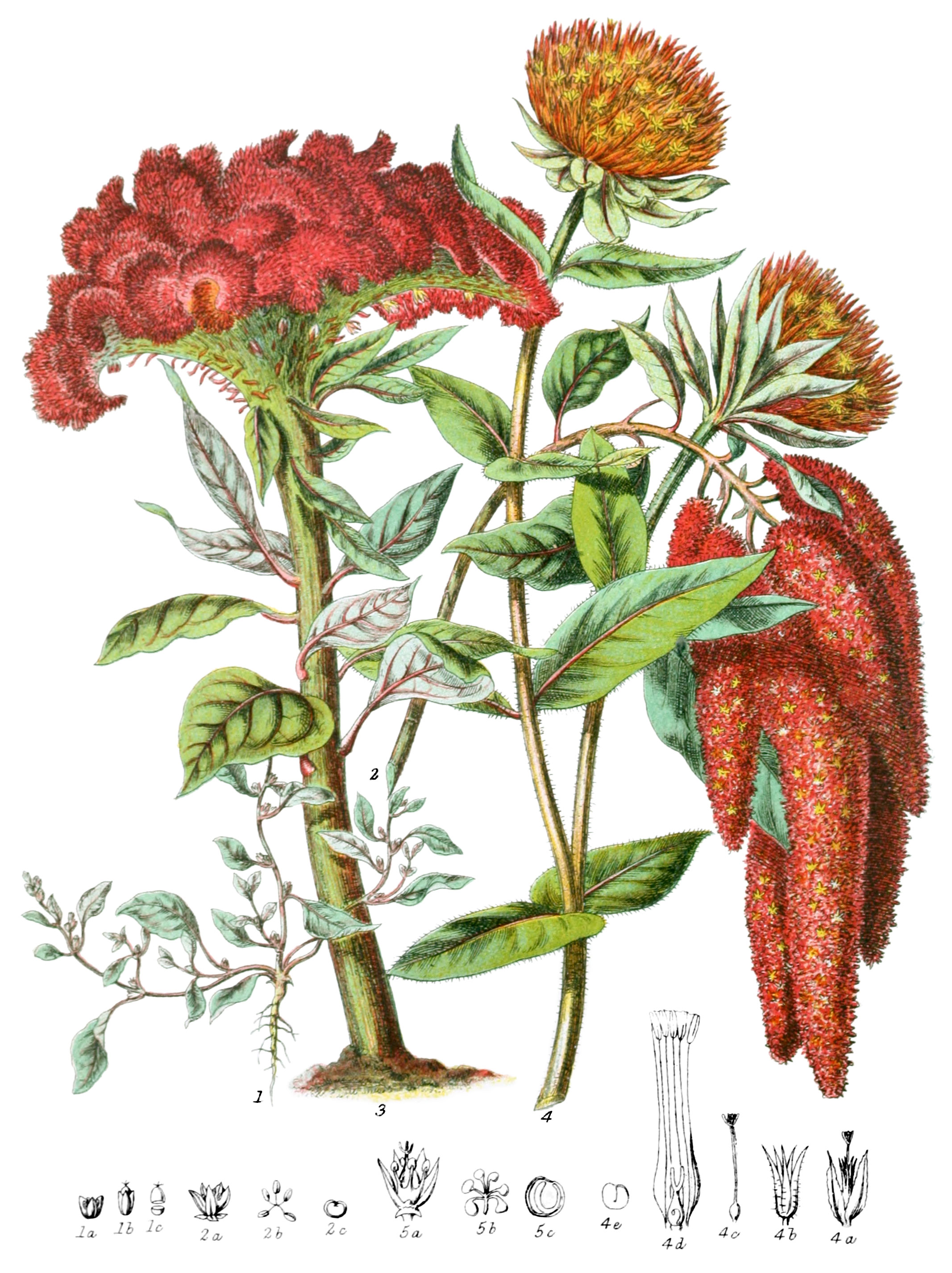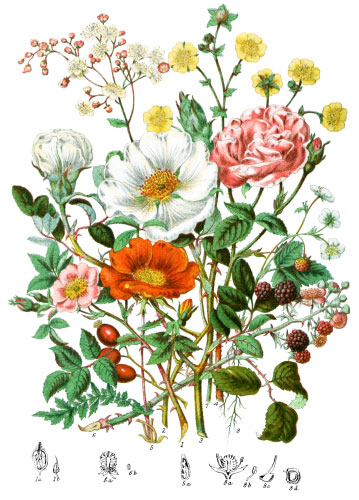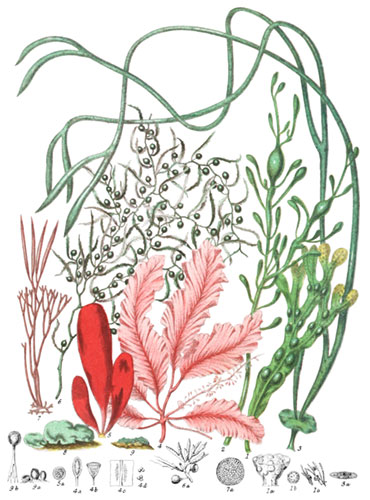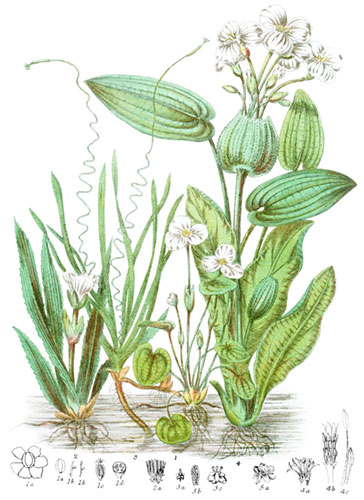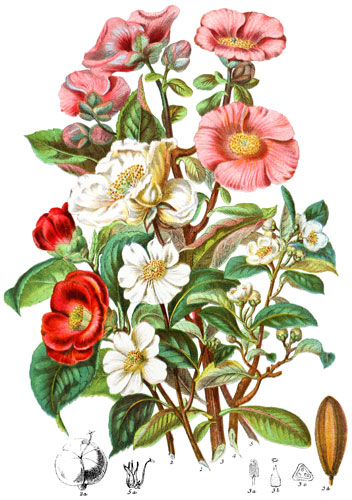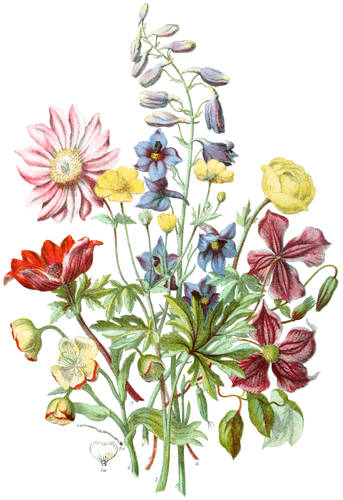Key characteristics
Shrubs and hers; the leaves are simple, opposite or alternate, without stipules. The flowers grow in heads or spikes, not always containing both stamens and pistil. The sepals are three or five, placed below the ovary, usually membranous, and coloured, sometimes herbaceous; distinct or united at the base, all equal, or an outer one dissimilar, often surrounded by dry, coloured bracts. The stamens are fixed at the base of the ovary, either five and opposite the sepals, or twice or thrice the number; either distinct or united; the anther one or two-celled. The ovary is single, free, containing one or a few ovules hanging from a central thread. The fruit is a membranous bag or a berry; the seeds are pendulous, and contain farinaceous albumen.
These plants have close affinity with Chenopodiaceæ.
Wholesome mucilaginous properties exist in the leaves.
Select plants in this order
Not all plants listed are illustrated and not all plants illustrated are listed.
- Amarantus is a name derived from the Greek, expressing its permanent nature and colour, many of the flowers retaining their bright colouring long after being gathered. The genus is dispersed in different proportions in each quarter of the world.
- A. Blitum (1) is the only British species, small in size, and of no beauty of colour; a striking example of the lowly form of a genus on the limits of its station, which in a more genial and favourable climate is developed into a superior size and brilliancy of colour. It is to be seen chiefly in boggy ground, near Cambridge and elsewhere. The seed is solitary, black, and shining. In this country it is considered a mere weed, but in some parts of France it is cooked and eaten by the poor peasants; for, like others of this Tribe, it contains a mild mucilaginous juice.
- A. caudatus (2) is an old favourite in the garden, having been introduced from the East Indies before the close of the sixteenth century. This and other species produce a large supply of seeds, which share in the durable nature of the flower, and preserve the power of germination many years.
- A. frumentaceus is cultivated for the sake of the seeds, like corn, in the Mysore country; A. Anardhana on the Himalayas for the same object.
- The species known as Prince’s-feather is stiff and erect, but some are of more graceful form and very ornamentl. Others are serviceable as food, and afford a wholesome supply; A. oleraceus, to the natives of Guinea, China, and similar hot countries.
- A. viridis is among the eatable herbs of the East Indies.
- Some are used medicinally; A. debilis is one of the medicinal species of Madagascar.
- Celosia crisata (3) is a remarkable plant of annual growth, attaining a wonderful development by cultivation and care; in Japan it is frequently to be seen, with the expanded flower-stalk covered with its countless minute flowers, as much as a foot in length and breadth. It is considered to have medicinal properties in India, where it is indiginous, as well as in China.
- C. margaritacea is found at moderate elevations on the Suen range of mountains.
- Gomphrena officinalis (4) is of high respute in its native country, supposed to be a remedy for all diseases, and the bite of snakes; G. macrocephala possesses similar properties, and the roots are tonic.
- G. globosa has been long known in our conservatories as the Globe Amaranth; the bright purple flowers remaining unwithered during many months.
- Achyranthes is a genus with dry membranous flowers of no particular beauty of form or colour, excepting A. porrigens, which has round* heads of crimson flowers.
- A. globulifera of Madagascar is employed as a medicine.
- A. aspera and A. futicosa are among the various medicinal plants used by the natives of India. Achyranthes inhabits also Norfolk Island, and extends into Europe as far as Sicily.
- Many of this tribe grow on the plains of India; some are traced along the base of the Himalaya, ascending to moderate elevations. Chamissoa, Alternanthera, Pupalia, and others, belong equally to America.
- Digera is common in India, and grows likewise in Arabia and Egypt.
- Deeringia is a native of India and Australia; Desmochetia spreads northwards in India, and is found also in Java and the Isle of Bourbon.
- Allmannia is scattered over the isles of the Indian Archipelago, and in Singapore.
- Cladostachys and Centrostachys are natives of Nepal.
- Polyscalis is peculiar to the mountains of India, flourishing at a higher elevation than any other plant of this tribe; P. sequax and P. capitata having been seen between 7000 and 8000 feet.
- Oplotheca floridana is a stiff, erect plant, bearing spikes of small white flowers, a native of Florida.
Locations
This Tribe is most abundant in the Tropics, especially of America, gradually diminishing in Temperate regions, unknown in the coldest countries; five species only belong to Europe. It is found in various localities, on plains and mountains, dry barren situations, salt marshes, or woods.
Legend
- Amarantus Blitum, Wild Amaranth. England.
- Flower with Stamens.
- Flower with Pistil.
- Seed-vessel.
- Amarantus caudatus, Love lies Bleeding. East Indies.
- Flower.
- Stamens.
- Seed.
- Celosia cristata, Crested Cock’s-comb. Asia.
- Gomphrena officinalis, Officinal Gomphrena. Brazil.
- Flower and Bracts.
- Calyx.
- Pistil.
- Flower open.
- Seed.
-
- Flower of C. longifolia.
- Stamens.
- Section of Seed.
* “round” was spelled “rounds” in the original description.
Explore more
Posters
Decorate your walls with colorful detailed posters based on Elizabeth Twining’s beautiful two-volume set from 1868.
Puzzles
Challenge yourself or someone else to assemble a puzzle of all 160 botanical illustrations.
